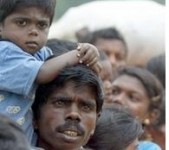Conflicting slants on Sri Lanka conflict

With independent sources being scarce, the extremely contradictory reports that filter through of what is indeed happening in neighbouring
Over the years, conflicting reports in so-called independent, pro-LTTE, pro-Sri Lankan, pro-Indian media have kept researchers and analysts busy. The common man (and woman too, of course!) had come to construct his own version of ¿truth¿ from the plethora of sources available off and online, based on his gut feelings and his personal experiences.
But easily these are the worst of times. With the pro-LTTE press either silent, or attributing all the deaths and disasters to the Sri Lankan army, and the Sri Lankan media reporting both army victories and Sri Lankan President Mahinda Rajapakse¿s litany of LTTE abuses, all that one can gather is that the situation is grave.
Among other reasons perhaps, and owing to this lack of clarity, the response of the Sri Lankan Tamils abroad has been, by and large, muted. The processions, and the calls for peace have all been devoid of any mention of the LTTE, with most organisations and individuals stressing the need to protect the innocent civilians caught in the cross fire. It is in this context that one wonders what the sources of information are in Tamil Nadu, where political parties and people are openly supportive of the LTTE.
A quick analysis of the press reports in Tamil Nadu since the intensification of the conflict in October 2008 reveals that the English and the Tamil media, with a few exceptions, have been speaking literally and figuratively in different languages. While the English newspapers have been reproducing the official government line, with barely a mention of the pro-LTTE sources, the Tamil newspapers, barring a few like Dinamani and Dinamalar, have been relying more on pro-LTTE sources.
The Tamil media that had turned hostile to the LTTE following former Prime Minister Rajiv Gandhi¿s assassination in 1991, warmed up towards the outfit following the ceasefire in 2001. This was apparent in the occasional feature articles in Tamil magazines that focussed on the north-east of
The July 31st poll in Ananda Vikatan (¿Ananda Vikatan¿s ¿amazing¿ poll on Eelam, The Hoot, Aug 5, 2008) that reportedly revealed ¿in no uncertain terms¿ what the average Indian Tamil thought about the Sri Lankan issue, appeared in the week when PTI reported that the Tigers¿ hold over the north and the east was weakening. In the week that the Chennai editions of both The Hindu and the Times of India editorialised the need for ¿prudence¿ in the State¿s response to the Sri Lankan Tamil situation, the Kumudam Reporter carried an interview with LTTE Commander Banu, while Ananda Vikatan ran a cover story indicting the Sri Lankan Army for the atrocities committed on Tamils. Interestingly, in the issue dated
In January 2009 when it was no longer possible to deny the Sri Lankan army¿s gains against the Tigers, Junior Vikatan, in its issue dated Jan 11, came out of its denial mode and featured LTTE supremo Prabhakaran¿s family on the cover, with a cover story on the Tigers¿ dream of a separate homeland now hopelessly torn asunder by President Rajapakse¿s Sinhala army. In the issue dated
In the context of media studies, the coverage can be assessed at different levels. First, the Tamil media seems to be providing a Habermasian public sphere engaging as it seemingly does in a dialogic exchange with the English media. There are four English newspapers and one English magazine in Tamil Nadu owned by the Hindu group, and all the newspapers quote Sri Lankan army sources. With the Tamil press, as exemplified by Vikatan and Kumudam defending the LTTE, there seems to be a dialogic exchange.
Secondly, the coverage of the Sri Lankan Tamil issue lays bare, yet again, the differences in ideologies/agenda of the English and the regional press in India. The regional press has been known to be more sympathetic to the regional, rather than the national cause, as was evident during the
Thirdly, it shows the ways in which regional and national interests are delicately balanced by the regional media. The ¿restraint¿ advised by the English newspapers is more in line with the national line of thinking. The Tamil press, as mentioned earlier, seems to disagree with the national line, and advocates a pro-LTTE posture. However, they are doing it in such a way that they do not fall foul of the national law, hence the need for a delicate balance.
Fourthly, it draws attention to issues of press freedom and media laws in the country; and fifthly, most significantly, the influence of the media in moulding public perceptions. Media laws are applicable here, as supporting and speaking in praise of a banned organisation is not a cognisable offence.
In the context of the above, it must be noted that the recent much-publicised suicide for the cause of the Sri Lankan Tamils, incidentally equated with the LTTE, was by a reporter who worked for a Tamil publication, Muthukumar.






